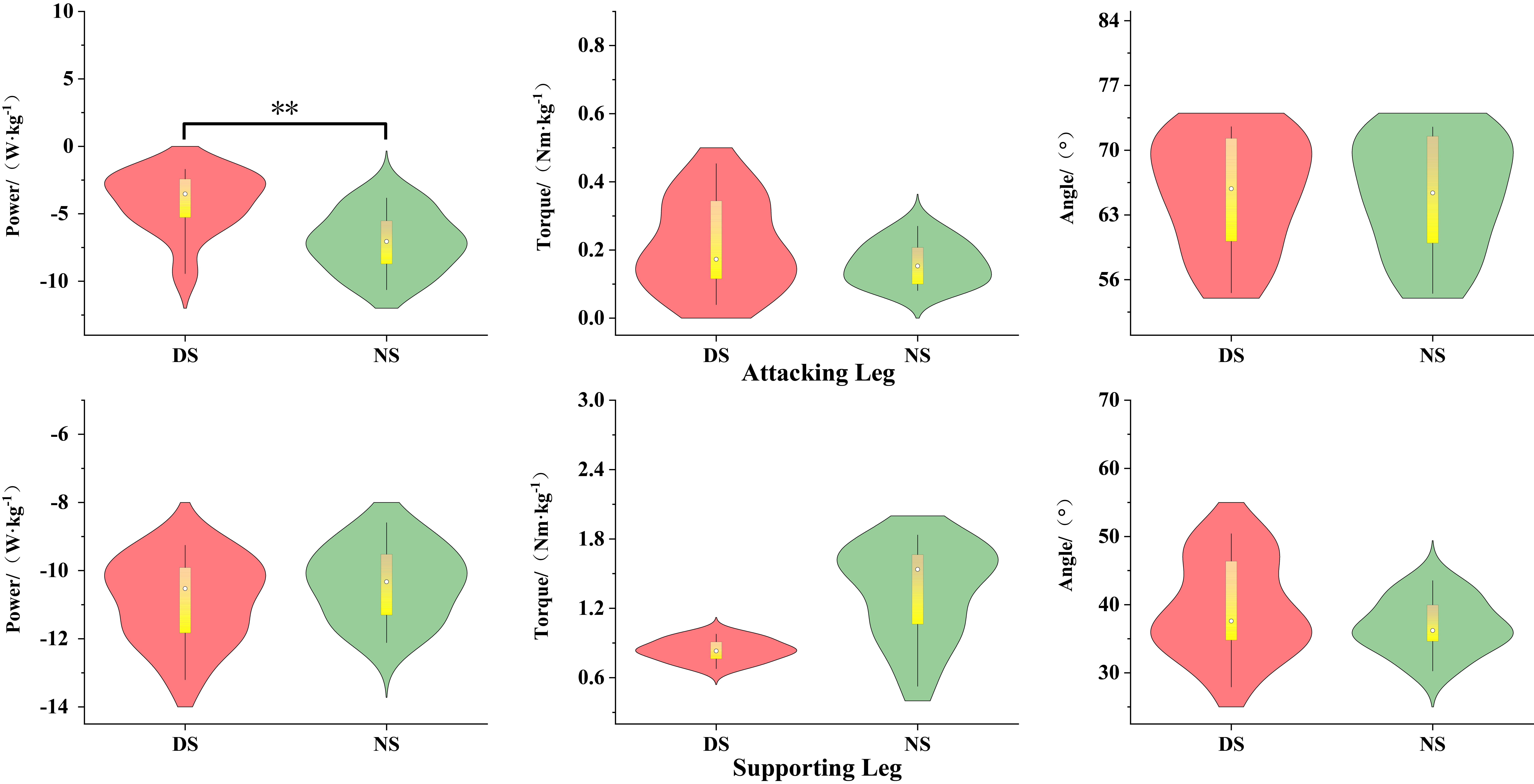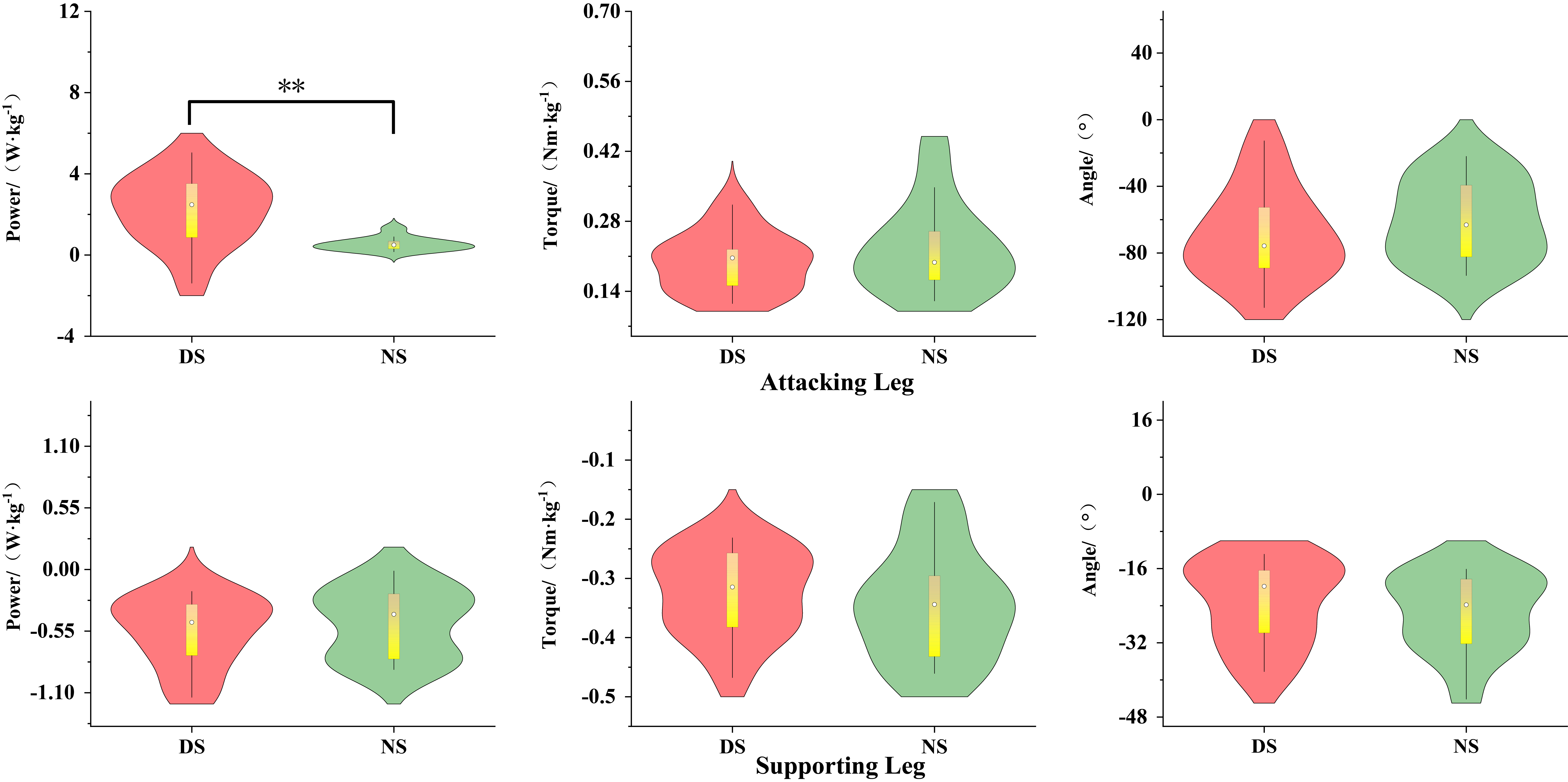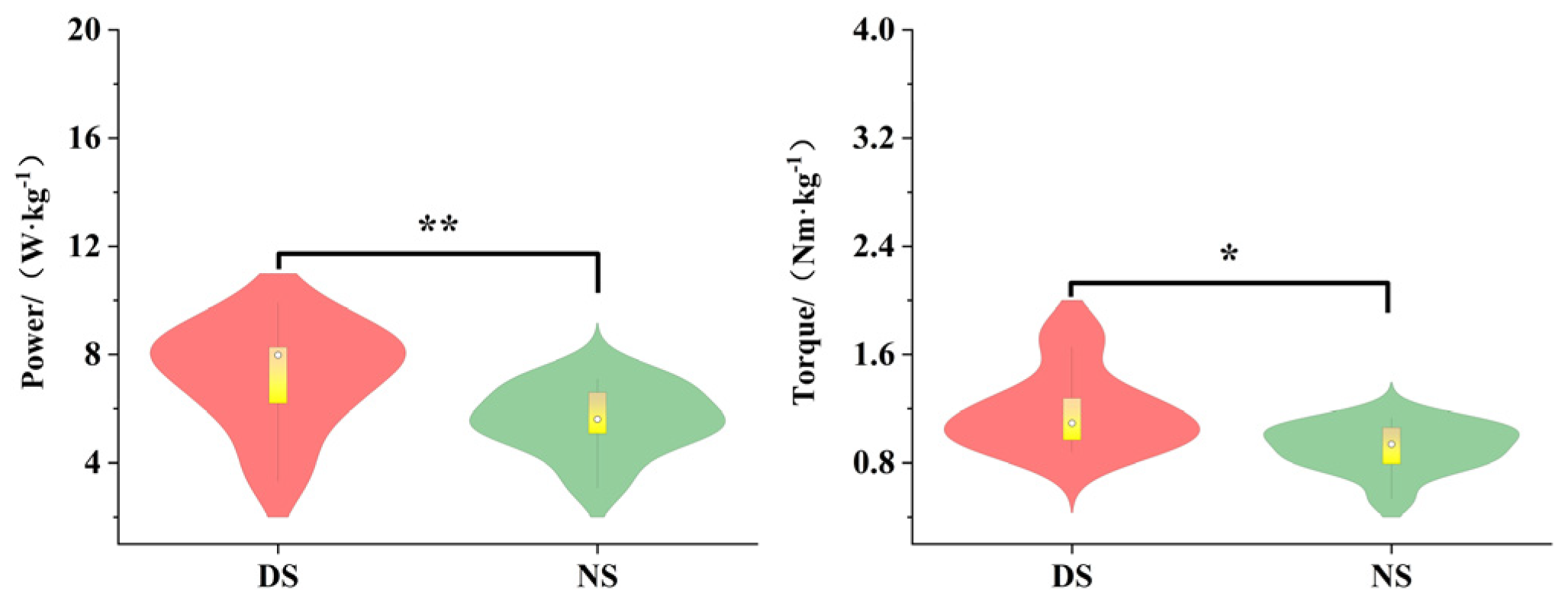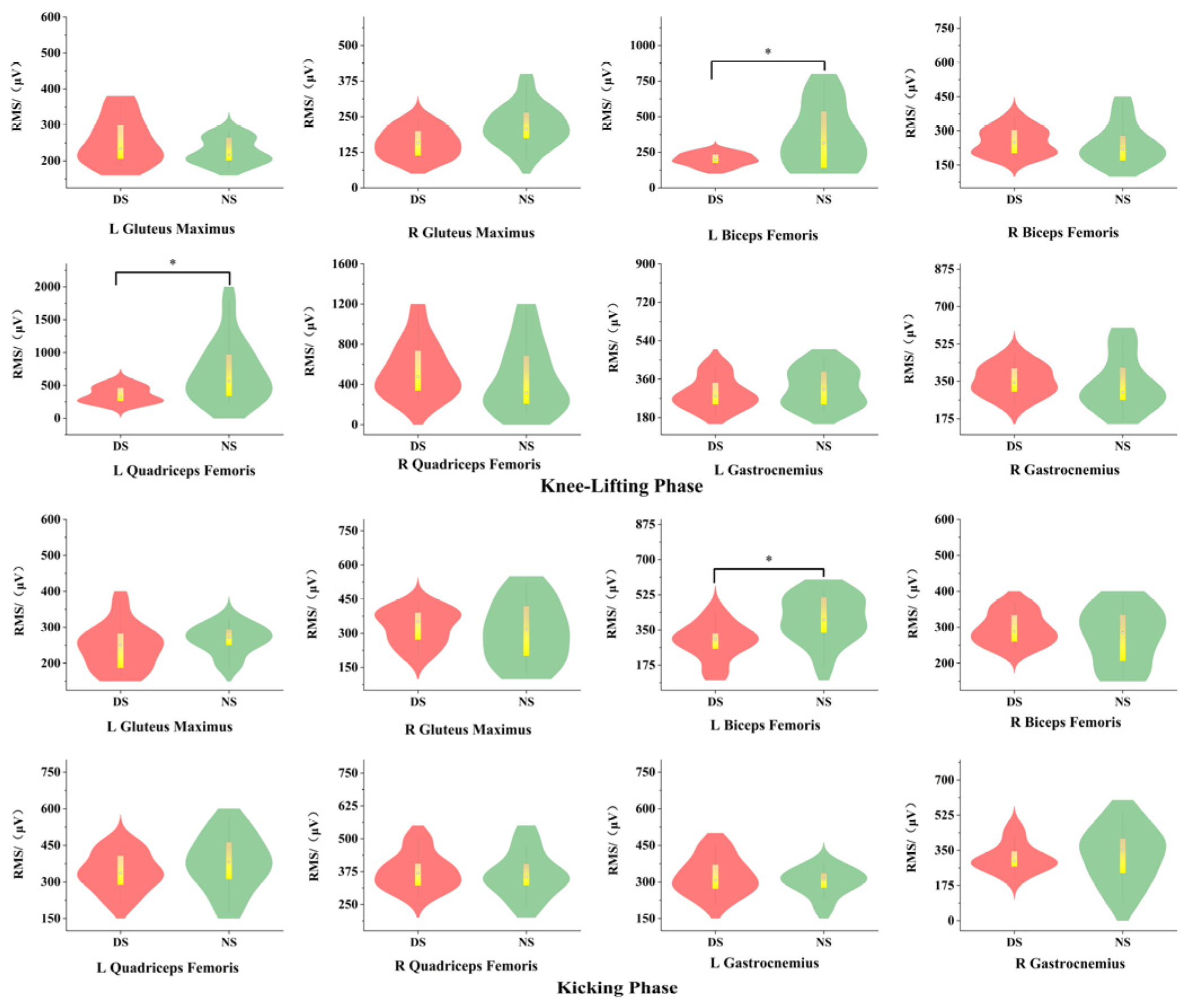Biomechanical Differences in Bilateral Lower Limb Movement During the Back Kick Technique of Outstanding Taekwondo Athletes
Abstract
1. Introduction
2. Materials and Methods
2.1. Research Subjects
2.2. Research Methods
2.2.1. Test Procedure
2.2.2. Data Processing
Action Phase Classification
Data Analysis
Statistical Analysis
3. Results
3.1. Biomechanical Characteristics of the Hip Joint


3.2. Biomechanical Characteristics of the Knee Joint
3.3. Biomechanical Characteristics of the Support Leg Ankle Joint
3.4. Surface Electromyography Characteristics
3.4.1. Integral Electromyography (IEMG) Feature Analysis
3.4.2. Root Mean Square (RMS) Amplitude Analysis
3.5. Striking Velocity and Vertical Ground Reaction Force Characteristics
4. Discussion
4.1. Kinematic and Kinetic Characteristics of the Lower Limb During the Knee-Lifting Phase
4.2. Kinematic and Kinetic Characteristics of Lower Limb Movement During the Kicking Phase
4.3. Surface Electromyographic Characteristics of the Lower Limb
4.4. Kick Momentum: Striking Velocity and Ground Reaction Force Characteristics
4.5. Limitations
4.6. Future Directions and Practical Applications
5. Conclusions
Author Contributions
Funding
Institutional Review Board Statement
Informed Consent Statement
Data Availability Statement
Conflicts of Interest
Abbreviations
| DS | Dominant side |
| NS | Non-dominant side |
References
- Arazı, H.; Hosseınzadeh, Z.; Izadı, M. Relationship between anthropometric, physiological and physical characteristics with success of female taekwondo athletes. Turk. J. Sport. Exerc. 2016, 18, 69–75. [Google Scholar] [CrossRef]
- Lee, J.H.; Kim, T.; Lee, M.; Ha, M.-S. Latent profile analysis of spinal deep muscle strength and physical fitness in elite Taekwondo athletes. BMC Sports Sci. Med. Rehabil. 2024, 16, 245. [Google Scholar] [CrossRef]
- Geßlein, M.; Rüther, J.; Bail, H.J.; Schuster, P.; Krutsch, W.; Wolpert, A.K. Injury Incidence Rates and Profiles in Outstanding Taekwondo during Competition and Training. Int. J. Sports Med. 2020, 41, 54–58. [Google Scholar] [CrossRef]
- Lin, D.S.; Gao, Z.H. Study on the application characteristics and training strategies of spinning kick skills in Taekwondo competitions under the new rules. J. Beijing Sport Univ. 2020, 43, 114–123. [Google Scholar] [CrossRef]
- Estevan, I.; Falco, C.; Elvira, J.L.L.; Vera-Garcia, F.J. Trunk and lower limb muscle activation in linear, circular and spin back kicks. Arch. Budo 2015, 11, 215–220. [Google Scholar]
- Ervilha, U.F.; Fernandes, F.D.M.; Souza, C.C.D.; Hamill, J. Reaction time and muscle activation patterns in elite and novice athletes performing a taekwondo kick. Sports Biomech. 2020, 19, 665–677. [Google Scholar] [CrossRef] [PubMed]
- Sun, J.; Wang, Y.; Dong, D. Lower limb electromyographic characteristics and implications of taekwondo roundhouse kick “hit” and “miss” actions. Front. Bioeng. Biotechnol. 2024, 11, 1258613. [Google Scholar] [CrossRef] [PubMed]
- Kim, K.; Davaasambuu, B.; Wei, R.; Li, Y. Biomechanical investigation of anterior cruciate ligament injury risk in pivoting leg during Taekwondo kicks using motion analysis system. J. Mech. Sci. Technol. 2022, 36, 1051–1056. [Google Scholar] [CrossRef]
- Yang, Z.Z.; Ma, Y.; Jia, M.Y.; Liu, L.; Ji, X.; Lin, S.; Zheng, W. Bilateral Biomechanical Differences of Lower Limbs in Taekwondo Athletes During Back Kick Movement. Sci. Technol. Eng. 2024, 24, 13726–13735. [Google Scholar]
- Liu, L.; Jia, M.; Ma, Y.; Lin, S.; Yang, Z. Biomechanics research on laterality effect between dominant and non-dominant during double roundhouse kick in the competitive Taekwondo. Heliyon 2023, 9, e20843. [Google Scholar] [CrossRef]
- Fox, K.T.; Pearson, L.T.; Hicks, K.M. The effect of lower inter-limb asymmetries on athletic performance: A systematic review and meta-analysis. PLoS ONE 2023, 18, e0286942. [Google Scholar] [CrossRef]
- Schorderet, C.; Hilfiker, R.; Allet, L. The role of the dominant leg while assessing balance performance: A systematic review and meta-analysis. Gait Posture 2021, 84, 66–78. [Google Scholar] [CrossRef]
- Helme, M.; Tee, J.; Emmonds, S.; Low, C. Does lower-limb asymmetry increase injury risk in sport? A systematic review. Phys. Ther. Sport 2021, 49, 204–213. [Google Scholar] [CrossRef]
- Zhao, S.; Chen, X.; Guo, L.; Wang, J.; Li, H. Analysis on tactical characteristics of Zhao Shuai in 2017 and 2019 World Taekwondo Championships. J. Southwest China Norm. Univ. (Nat. Sci. Ed.) 2021, 46, 136–140. [Google Scholar]
- Xu, C.; Liu, W.; Liu, D.; Wang, J. Effect of hitting speed of four tactical movements of Taekwondo back roundhouse kick and its enlightenment for sports training. J. Chengdu Sport Univ. 2020, 46, 114–120. [Google Scholar]
- Zhou, C.; Yu, D. Biomechanical characteristic analysis on elite men’s Taekwondo horizontal kicking techniques. J. Shandong Sport Univ. 2010, 26, 58–63. [Google Scholar]
- Gutiérrez-Santiago, A.; Pereira-Rodríguez, R.; Prieto-Lage, I. Detection of the technical and tactical motion of the scorable movements in Taekwondo. Physiol. Behav. 2020, 217, 112813. [Google Scholar] [CrossRef]
- Menescardi, C.; Falco, C.; Ros, C.; Morales-Sánchez, V.; Hernández-Mendo, A. Technical-tactical actions used to score in Taekwondo: An analysis of two medalists in two Olympic Championships. Front. Psychol. 2019, 10, 2708. [Google Scholar] [CrossRef] [PubMed]
- Li, Y.; Huang, P.; Wang, H.; Zhang, Y. Dominant and non-dominant side knee isokinetic characteristics of Chinese calisthenics athletes. Chinese J. Tissue Eng. Res. 2021, 25, 232–236. [Google Scholar]
- Mao, X.; Zhang, Q.; Wang, G.; Li, S. Biomechanical laterality effect between the dominant and non-dominant during running support phase. J. Cap. Univ. Phys. Educ. Sports 2017, 29, 91–96. [Google Scholar]
- Bishop, C.; Read, P.; McCubbine, J.; Turner, A. Vertical and horizontal asymmetries are related to slower sprinting and jump performance in elite youth female soccer players. J. Strength Cond. Res. 2021, 35, 56–63. [Google Scholar] [CrossRef]
- Pietraszewski, P.; Gołaś, A.; Matusiński, A.; Mrzygłód, S.; Mostowik, A.; Maszczyk, A. Muscle activity asymmetry of the lower limbs during sprinting in elite soccer players. J. Hum. Kinet. 2020, 75, 239–245. [Google Scholar] [CrossRef]
- Aloui, A.; Tayech, A.; Mejri, M.A.; Hammami, M.; Chtourou, H.; Chaouachi, A. Reliability and validity of a new Taekwondo-specific change-of-direction speed test with striking techniques in elite Taekwondo athletes: A pilot study. Front. Physiol. 2022, 13, 774546. [Google Scholar] [CrossRef]
- Góra, T.; Mosler, D.; Podstawski, R.; Wąsik, J. The Impact of Effective Mass on the Strength of Side and Turning Kick in Taekwon-Do Male Practitioners. Appl. Sci. 2024, 14, 2339. [Google Scholar] [CrossRef]
- Wąsik, J.; Shan, G. Kinematics of the turning kick—Measurements obtained in testing well-trained taekwon-do athletes. Arch. Budo 2015, 11, 61–67. [Google Scholar]
- Paulauskas, R.; Pundzevicius, V.; Figueira, B. Effects of eight weeks incremental elastic resistance training on roundhouse kick quality and physical performance in Taekwondo athletes in a randomized controlled trial. Sci. Rep. 2025, 15, 15054. [Google Scholar] [CrossRef]
- Hasan, U.C. Statistical and Practical Significance of Articles at Sports Biomechanics Conferences. Ann. Appl. Sport Sci. 2021, 9. [Google Scholar] [CrossRef]
- Souza, R.L.M.; Aidar, F.J.; Villar, R.; Fernandes, R.P.; Júnior, A.T.D.B.; de Oliveira, J.V. Assessment of asymmetry at different intensities between conventional and paralympic powerlifting athletes. Heliyon 2023, 9, e16211. [Google Scholar] [CrossRef]
- Phuaklikhit, C.; Junsri, T. The correlation of centre of mass evaluation utilising accelerometry-based measurement and the clinical dynamic balance test in professional football athletes with chronic ankle instability. Heliyon 2023, 9, e17318. [Google Scholar] [CrossRef]
- Liu, H.; Fu, W.; Wu, X.; Guo, L.; Wu, Y. Biomechanical laterality betweendominant and non-dominant legs during single-leg landing. China Sport Sci. 2014, 34, 70–76. [Google Scholar] [CrossRef]
- Shi, S.; Ni, X.; Ieong, L.; Li, L.; Liu, Y. Comparison of time–frequency characteristics of lower limb EMG signals among different foot strike patterns during running using the EEMD algorithm. Life 2025, 15, 1386. [Google Scholar] [CrossRef]
- Tan, Y.; Li, W. Application of surface electromyography in rehabilitation assessment of athletes’ thigh muscle strains. Chin. J. Rehabil. Theory Pract. 2018, 24, 1082–1086. [Google Scholar]
- Dong, D.L.; Guo, H.F.; Wang, W.X. Surface Electromyography Characteristics of Back Kick Technique in Chinese National Male Taekwondo Athletes. J. Beijing Sport Univ. 2013, 36, 68–71. [Google Scholar] [CrossRef]
- Moreira, P.V.; Goethel, M.F.; Gonçalves, M. Neuromuscular performance of Bandal Chagui: Comparison of subelite and elite taekwondo athletes. J. Electromyogr. Kinesiol. Off. J. Int. Soc. Electrophysiol. Kinesiol. 2016, 30, 55–65. [Google Scholar] [CrossRef]
- Jin, M.J. Kinematics Analysis of Kick Back Technique in Taekwondo. Master’s Thesis, Tianjin Sports University, Tianjin, China, 2016. [Google Scholar]
- Zhang, Y.; Lu, A. Performance of dominant-side and non-dominant-side in the continuous vertical jump landing stage. China Sport Sci. 2013, 33, 68–73. [Google Scholar]
- Peng, Q.; Ma, Y.; Liu, L.; Jia, M. Biomechanical characteristics of Taekwondo athletes’ whirlwind kick technique under the score of Daedo electronic protective equipment. In Proceedings of the 12th National Sports Science Conference, Rizhao, China, 25–27 March 2022; pp. 161–162. [Google Scholar]
- Kim, S.; Miller, M.; Tallarico, A.; Kim, Y.; Son, J. Relationships between physical characteristics and biomechanics of lower extremity during the squat. J. Exerc. Sci. Fit. 2021, 19, 269–277. [Google Scholar] [CrossRef]
- Wang, Q.; Li, L.; Mao, M.; Wang, X.; Sun, W. The relationships of postural stability with muscle strength and proprioception are different among older adults over and under 75 years of age. J. Exerc. Sci. Fit. 2022, 20, 328–334. [Google Scholar] [CrossRef]
- Sun, Q.C.; Li, H.; Deng, D.L. Biomechanical Analysis of Roundhouse Kick Technique in Taekwondo Athletes. J. Med. Biomech. 2024, 39, 1236. [Google Scholar]
- Kazemi, M.; Perri, G.; Soave, D. A profile of 2008 Olympic Taekwondo competitors. J. Can. Chiropr. Assoc. 2010, 54, 243. [Google Scholar] [PubMed]
- Shenoy, S.; Mishra, P.; Sandhu, J.S. Peak torque and IEMG activity of quadriceps femoris muscle at three different knee angles in a collegiate population. J. Exerc. Sci. Fit. 2011, 9, 40–45. [Google Scholar] [CrossRef]
- Ryu, S.; Lee, T.K. Biomechanical parameters that may influence lower limb injury during landing in Taekwondo. Medcina 2021, 57, 373. [Google Scholar] [CrossRef] [PubMed]
- Huang, R.; Ma, Y.; Lin, S.; Zheng, W.; Liu, L.; Jia, M. Research on the biomechanical laterality of athletes’ lower limbs during side kick in the competitive Taekwondo. Sci. Rep. 2025, 15, 10180. [Google Scholar] [CrossRef]
- Maloney, S.J. The relationship between asymmetry and athletic performance: A critical review. J. Strength Cond. Res. 2019, 33, 2579–2593. [Google Scholar] [CrossRef]
- Laett, C.T.; Silva, R.; Cossich, C.F.S.; Nunes, R.A.M.; de Andrade, A.G.P. Maximum and explosive strength in Brazilian kickboxing athletes: Asymmetries between limbs and the relationship with the single jump distance. Sport Sci. Health 2023, 19, 241–247. [Google Scholar] [CrossRef]
- Lu, C.; Fan, Y.; Yu, G.; Chen, H.; Sinclair, J.; Fan, Y. Asymptomatic foot and ankle structural injuries: A 3D imaging and finite element analysis of elite fencers. BMC Sports Sci. Med. Rehabil. 2022, 14, 50. [Google Scholar] [CrossRef]
- Estevan, I.; Freedman Silvernail, J.; Jandacka, D.; Falco, C. Segment coupling and coordination variability analyses of the roundhouse kick in taekwondo relative to the initial stance position. J. Sports Sci. 2016, 34, 1766–1773. [Google Scholar] [CrossRef] [PubMed]
- Su, J.; Zhang, Y.; Ma, S. Effects of hitting velocity of different level sanda athletes whip-leg movement. J. Wuhan Sports Univ. 2018, 52, 87–94. [Google Scholar]
- Lei, J.T.; Bai, Z.M.; Zhang, H.Y.; Wang, J.Y.; Li, Y. Application progress of nonlinear dynamics analysis methods in electromyography signals. Chin. J. Sports Med. 2024, 43, 554–562. [Google Scholar]
- Bouhlel, E.; Jouini, A.; Gmada, N.; Nefzi, A. Electromyographic activity and kinematic analysis of three different Taekwondo kicking techniques in elite athletes. J. Strength Cond. Res. 2015, 29, 355–365. [Google Scholar]
- Tasika, N. Reliability & linearity of an electronic body protector employed in Taekwondo games: A preliminary study. J. Hum. Sport Exerc. 2013, 8, S622–S632. [Google Scholar] [CrossRef]
- Zhu, X.Q.; Liu, F.H. Effects of Plyometric Training on Lower Limb Power in Male University Basketball Players. J. Appl. Mech. 2025, 42, 712–722. [Google Scholar]
- Li, Z.; Ren, M.Y. Effects of Complex Training with Different Loads on Lower Limb Maximum Strength, Power, and Special Physical Test Indicators in Male Judo Athletes. China Sport Sci. Technol. 2024, 60, 21–31. [Google Scholar]






| Indicator | DS | NS | t | p |
|---|---|---|---|---|
| Striking speed/(m·s−1) | 0.67 ± 0.12 | 0.53 ± 0.08 | 3.362 | 0.006 |
| Vertical ground reaction force/BW | 100.78 ± 42.81 | 104.79 ± 42.43 | −0.325 | 0.751 |
Disclaimer/Publisher’s Note: The statements, opinions and data contained in all publications are solely those of the individual author(s) and contributor(s) and not of MDPI and/or the editor(s). MDPI and/or the editor(s) disclaim responsibility for any injury to people or property resulting from any ideas, methods, instructions or products referred to in the content. |
© 2025 by the authors. Licensee MDPI, Basel, Switzerland. This article is an open access article distributed under the terms and conditions of the Creative Commons Attribution (CC BY) license (https://creativecommons.org/licenses/by/4.0/).
Share and Cite
Xu, Q.; Yan, H.; Yang, J.; Shan, W. Biomechanical Differences in Bilateral Lower Limb Movement During the Back Kick Technique of Outstanding Taekwondo Athletes. Life 2025, 15, 1822. https://doi.org/10.3390/life15121822
Xu Q, Yan H, Yang J, Shan W. Biomechanical Differences in Bilateral Lower Limb Movement During the Back Kick Technique of Outstanding Taekwondo Athletes. Life. 2025; 15(12):1822. https://doi.org/10.3390/life15121822
Chicago/Turabian StyleXu, Qinjian, Hongwei Yan, Junli Yang, and Wei Shan. 2025. "Biomechanical Differences in Bilateral Lower Limb Movement During the Back Kick Technique of Outstanding Taekwondo Athletes" Life 15, no. 12: 1822. https://doi.org/10.3390/life15121822
APA StyleXu, Q., Yan, H., Yang, J., & Shan, W. (2025). Biomechanical Differences in Bilateral Lower Limb Movement During the Back Kick Technique of Outstanding Taekwondo Athletes. Life, 15(12), 1822. https://doi.org/10.3390/life15121822






